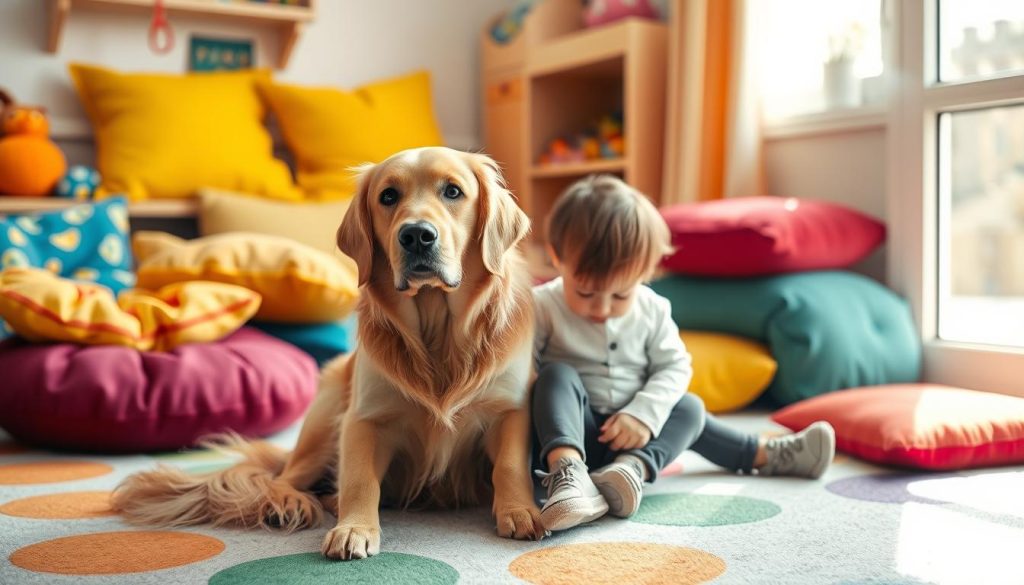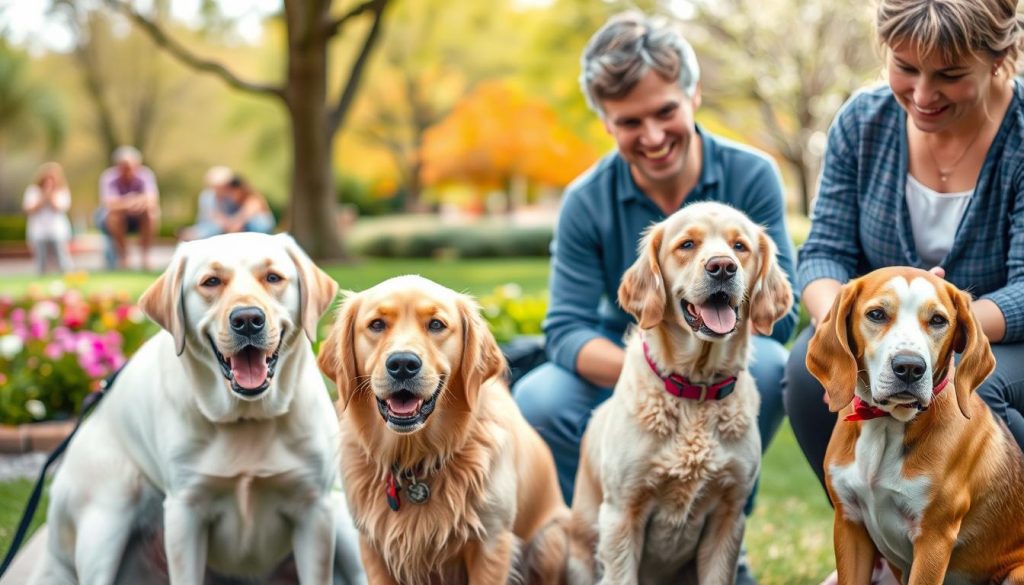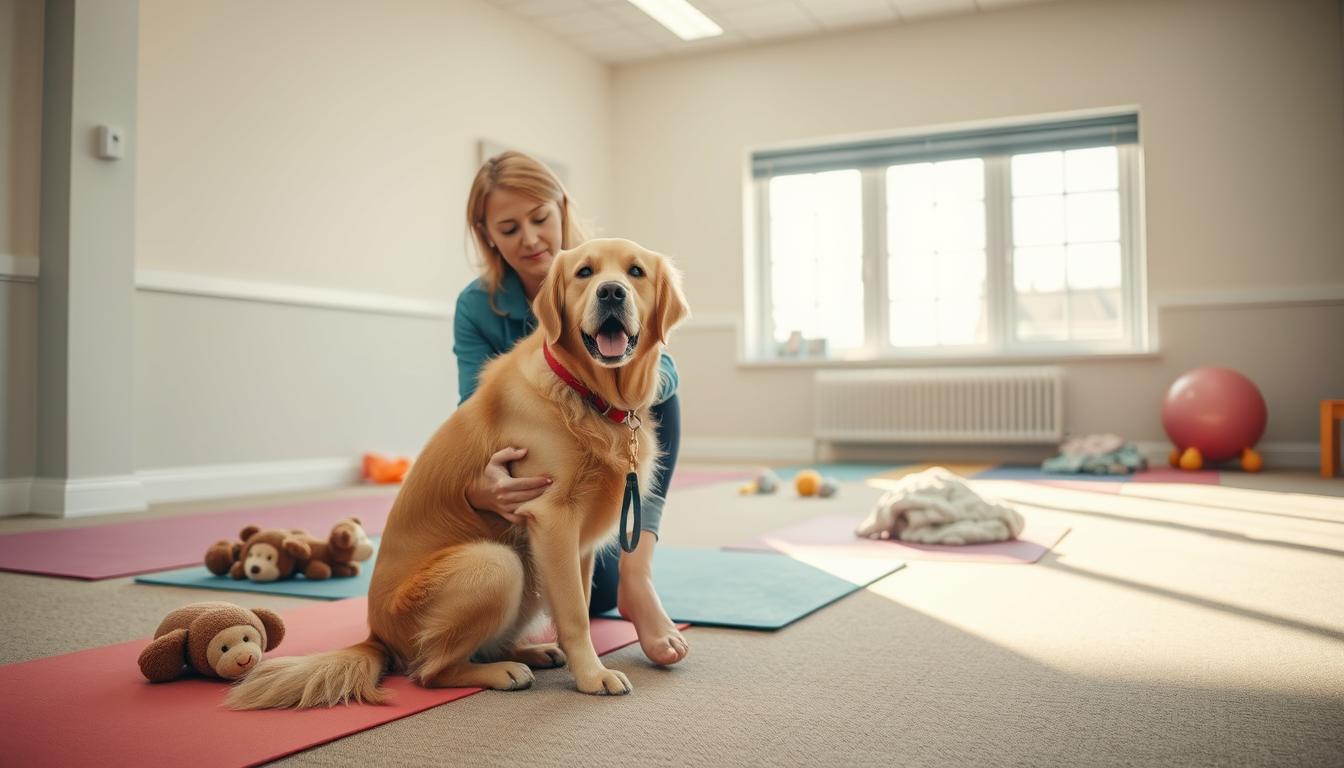Ever thought about turning your dog into a certified therapy dog? It’s a rewarding journey for you and your dog. But, where do you start? What qualities does your dog need, and how do you train them?
This guide covers therapy dog training from start to finish. We’ll talk about why these dogs are so special, how to pick the right one, and the certification process. It’s perfect for new owners or seasoned handlers looking to start their therapy dog journey.
Ready to unlock your dog’s potential and help others? Let’s explore how to train a therapy dog that will touch everyone’s heart.
Understanding the Importance of Therapy Dogs
Therapy dogs play a key role in healthcare and community settings. They offer comfort, companionship, and emotional support to those in need. Their presence can reduce stress, anxiety, and loneliness, boosting both physical and mental health.
Therapy dogs have many benefits. They can help with depression, chronic illness pain, and even in rehabilitation. These dogs work in hospitals, nursing homes, schools, and community centers. They aim to positively impact the lives of those they meet.

Quick Recommendation : Our blog is filled with tips , tricks, and methods for training your dog. If you would like to attend the Free Dog Training Workshop, we recommend the K9 Training Institute.
It’s crucial to know the difference between therapy dogs and emotional support dogs. Therapy dogs are trained for professional settings and help in specific ways. Their main goal is to enhance the well-being of those they meet, whether through reducing anxiety or offering comfort.
Learning about therapy dogs is the first step to becoming a team. Discovering how they can make a difference helps you decide if this path is right for you and your dog.
Choosing the Right Dog for Therapy Work
Choosing the right dog for therapy work is a big decision. You need to look at your dog’s temperament, personality, and how they act. The best dogs for therapy are calm, patient, and love people.
It doesn’t matter if your dog is a purebred or a mix. What’s important is their temperament, not their breed.
The ideal therapy dog should be the right size and age. Small dogs might be better for some places, while big dogs can make people feel safe. Dogs should be between 1 and 10 years old for therapy work. Older dogs might find it hard, and puppies need more training.

Quick Recommendation : Our blog is filled with tips , tricks, and methods for training your dog. If you would like to attend the Free Dog Training Workshop, we recommend the K9 Training Institute.
By checking your dog’s traits and making sure they fit the criteria, you can find the perfect therapy dog. The best dogs are those that can handle different places, enjoy being around people, and love interacting with humans.
Essential Traits and Temperament for Therapy Dogs
Thinking about training your dog for therapy work? It’s key to know the traits and temperament needed. Therapy dogs have special qualities that help them in healthcare and community settings.
Calmness and patience are crucial for therapy dogs. They must stay calm in new situations. They should wait patiently to interact with others without getting anxious.
Sociability and a friendly nature are also vital therapy dog temperament traits. Therapy dogs need to be comfortable with people of all ages. They should be eager to comfort and support others.
Adaptability and responsiveness are also important ideal therapy dog personality traits. Therapy dogs must adjust to different places and situations. They should listen well to their human partners and follow commands.
Knowing the therapy dog behavior traits helps your dog make a big difference. It ensures they are ready to help others.
Training a Dog for Therapy Work
Starting the therapy dog training journey is both thrilling and fulfilling for you and your dog. To make your dog a skilled therapy dog, you’ll need to focus on obedience and socialization. You’ll also need to teach specific therapy dog skills. This step-by-step approach will get your pup ready to excel as a therapy dog.
The training program will teach your dog important commands like sit, stay, come, and heel. Socialization is key, too. It helps your dog get used to different people, animals, and places. As training goes on, you’ll teach your dog to stay calm and focused when meeting patients or clients.
It’s vital to use positive reinforcement during the training to strengthen your bond and trust. With consistent practice, patience, and attention to your dog’s needs, you’ll see great results. Your efforts will pay off with a loyal and skilled therapy dog. This dog will bring happiness and comfort to those who need it most.
Exposure to Different Environments and Situations
Getting your therapy dog ready for work means showing them many places and situations. They need to feel at ease in places like busy hospitals and quiet nursing homes. This training is key for their social skills and helping others.
Start by getting your dog used to hospitals and healthcare places. Let them get used to the sounds, smells, and sights. Make sure they stay calm and friendly around medical stuff and people moving around.
Then, take your dog to nursing homes and places for older adults. These places have their own challenges, like people moving slowly or having trouble remembering things. Teach your dog to stay calm and comfort those who need it.
Don’t forget about schools, libraries, and places for seniors. These spots are great for your dog to meet lots of people. It helps them learn to be friendly and comfortable in different places.
By showing your dog many places, you make sure they’re ready for their job. This training helps them give the best care and comfort to those they help.
Maintaining Certification and Continuing Education
Getting certified as a therapy dog team is just the beginning. To keep your dog’s certification up to date, you need ongoing education and training. This section will cover the steps to renew your certification and why continuing education is key.
Keeping your therapy dog certified is vital for excellent service. Most groups ask for annual recertification. You’ll show your dog’s obedience, temperament, and skills in different places. This includes a detailed evaluation to make sure your dog is ready for their work.
Continuing education for therapy dogs is also important. Workshops and training sessions can teach you and your dog new things. You’ll learn how to interact with different people and handle tough situations. This learning helps you and your dog grow closer and serve better.
Investing in your therapy dog’s certification and education shows your commitment. It ensures your team can make a real difference in people’s lives. By focusing on your dog’s skills, you provide the best care and support to your community.
Building a Positive Reinforcement Training Plan
Effective therapy dog training uses positive reinforcement. This means using rewards and clicker training to teach your dog. It helps them learn good behaviors and do well in their therapy work.
Positive reinforcement training, also known as clicker training, is very effective. It rewards good actions instead of punishing bad ones. This method helps your dog learn faster and builds a strong bond between you and your dog.
To start your positive reinforcement training, list the behaviors you want your dog to learn. These could be things like being calm, attentive, and quick to follow commands. Then, make a training plan that includes rewards like treats, praise, and playtime.
Consistency is crucial in therapy dog training. Stick to a regular training schedule and always give positive reinforcement. This will help your dog become confident and skilled in their therapy role.
Quick Recommendation : Our blog is filled with tips , tricks, and methods for training your dog. If you would like to attend the Free Dog Training Workshop, we recommend the K9 Training Institute.
Overcoming Challenges in Therapy Dog Training
Therapy dog training is rewarding but comes with challenges. You might face issues like trouble focusing or responding to distractions. It’s important to overcome these to make sure your dog can comfort and support others.
Adaptability is a key strategy for overcoming therapy dog training challenges. Be ready to change your training methods to fit your dog’s needs and how they learn. Some dogs do better with positive reinforcement, while others need a more structured approach. Stay patient and open to trying different techniques to find what works for your dog.
It’s also important to tackle therapy dog behavior issues directly. If your dog has anxiety, gets easily distracted, or has other behavioral problems, get help from a professional dog trainer or animal behaviorist. They can offer specific solutions to help your dog become a confident, well-adjusted therapy dog.
Consistency and repetition are crucial when training a therapy dog. Take your dog to different places and situations, starting with simple ones. Gradually increase the difficulty to build their confidence and resilience. Use positive reinforcement and patience as you face any challenges that come up.
Bonding and Building Trust with Your Therapy Dog
Building a strong bond and trust with your therapy dog is key for success. The bond between you and your dog is the base of your teamwork. It helps you make a big difference in your community.
Bonding with your therapy dog is more than just training. It’s about creating a deep emotional connection. You need patience, consistency, and positive feedback. As you spend time together, play, and face challenges, trust grows.
The relationship between you and your therapy dog is a balance. You lead, but also let your dog shine. Clear communication and teamwork make a big impact on those you meet.
Investing in your bond with your therapy dog is rewarding for both of you. When your dog feels safe and loved, they can focus on helping others. This emotional support can change lives.
Conclusion
Training a dog for therapy work is a rewarding journey. It starts with understanding the role of therapy dogs. Then, you need to choose the right dog and nurture their traits.
The training process has its challenges. But with dedication and patience, you and your dog can make a big difference. Your bond with your dog is key to your success.
Starting this journey is exciting. You’ll bring joy and comfort to those who need it. Every moment with your dog is special, and together, you can change lives.
Quick Recommendation : Our blog is filled with tips , tricks, and methods for training your dog. If you would like to attend the Free Dog Training Workshop, we recommend the K9 Training Institute.

